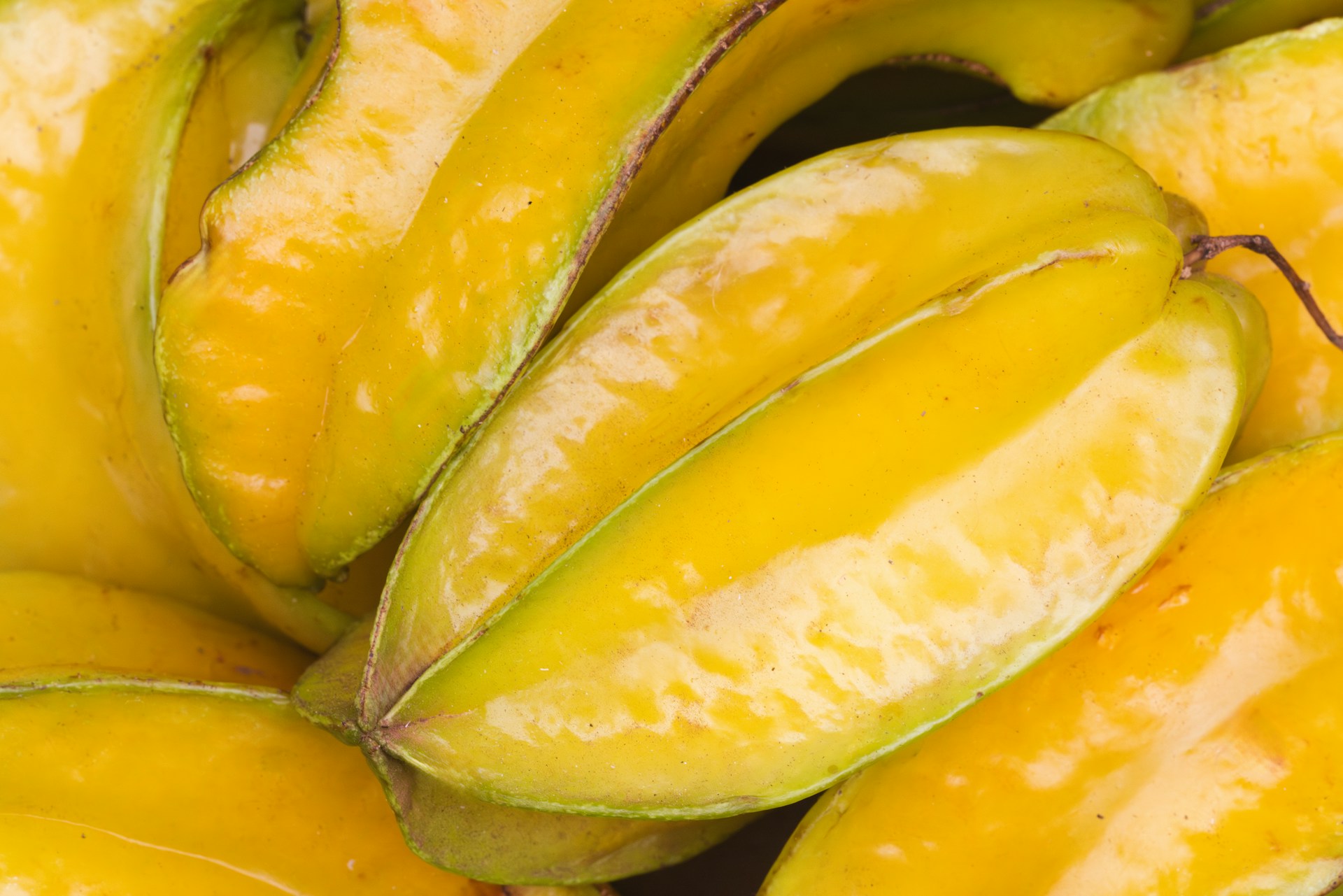Nutrition
Discover 10 Exotic Fruits That Could Boost or Harm Your Health

Fruit is a key component of a healthy diet, offering vitamins, minerals, and often that little touch of sweetness we crave. While you can easily find standard strawberries, apples, oranges, bananas, and more at the grocery store, there are some uncommon fruits you can’t find at your local Walmart or Kroger. Data recently compiled by experts at Med Genius identified the 10 most-Googled lesser-known fruits in the U.S., identifying 10 varieties you may want to try.
But before you go out in search of these more obscure options, keep in mind that not all fruits are created equal in terms of their health benefits. According to Trista Best, a registered dietitian at Balance One Supplements, and Jacek Szymanowski, PN-Certified nutritionist at Torokhtiy, these 10 uncommon fruits can have both positive and negative effects on your overall health. Read on to find out what you should know before sampling.
Breadfruit
Breadfruit originated in New Guinea and the Indo-Malay region and is often used when cooking. According to the Hawai’i Homegrown Food Network and the Breadfruit Institute of the National Tropical Botanical Garden, the fruit can be eaten on its own with butter and salt and also works as a substitute for potatoes.
Breadfruit can bolster your health as it’s a good source of fiber and potassium, which support heart health and digestion. However, you can have too much of a good thing. When you overeat breadfruit, it can cause digestive discomfort as a result of its fiber content, the experts add.
Starfruit
Aptly named, starfruit forms star-shaped pieces when it’s cut crosswise. While it’s native to Southeast Asia, it is now grown in Florida and Hawaii on Carambola trees. The fruit has a “slightly sweet-sour flavor,” like a combination of pear, green grape, and orange. It’s a good source of vitamins C and A, phosphorous, and potassium.
However, starfruit also has oxalates, “which can be harmful to individuals with kidney issues, potentially leading to kidney stones or toxicity.” The National Kidney Foundation backs this up, explaining that substances in starfruit can affect the brain and cause neurological disorders.
“This toxic substance is called a neurotoxin. People with healthy, normal kidneys can process and pass this toxin out from their body. However, for those with kidney disease, this is not possible. The toxin stays in the body and causes serious illness,” the foundation warns.
Prickly Pear
You’ve probably seen prickly pear as an ingredient in a cocktail or mocktail, but it’s not just an advertising gimmick using alliteration. Prickly pears actually exist and have a sweet but “somewhat bland” flavor like melon. Interestingly enough, the prickly pear isn’t a member of the pear family. It got its name because it resembles a pear in size and shape.
Like other fruits on this list, prickly pear is high in fiber, vitamin C, and antioxidants, which help with digestion and reduce inflammation. According to the Mayo Clinic, some evidence suggests that it can decrease blood sugar levels in those with type 2 diabetes. However, it can also cause some gastrointestinal issues if you overdo it.
“Overconsumption may lead to bloating, diarrhea, or constipation due to its high fiber content,” they warn.
Mangosteen
Not to be confused with your typical mangoes, mangosteen is dark purple or red and has an acidic and sweet taste. It has xanthones, which are known to have anti-inflammatory properties and boost immunity. The fruit is also often used for “serious gum infections, obesity, muscle strength, diarrhea, and many other conditions.”
Still, mangosteen can have detrimental health effects.
“Rarely, mangosteens can cause gastrointestinal upset or allergic reactions, and excessive consumption might affect blood sugar levels,” Szymanowski and Best say. The fruit is “possibly safe when taken for up to 12 weeks.”
Goji Berries
You may have heard of goji berries, which are well-known as a source of vitamin A, supporting eye health and your immune system. They are brightly colored and have a “unique, sour flavor,” and they’re sometimes sold powdered, dried, or as an ingredient in supplements.
However, you should be mindful of goji berries if you take other medications.
“They can interact with certain medications, such as blood thinners, and may cause allergic reactions in some individuals,” Szymanowski and Best warn.
Kumquat
The kumquat is a teeny citrus fruit, but what it lacks in size, it makes up for in vitamin content. They’re “loaded with vitamin C and fiber,” aiding digestion when you eat the whole fruit (including the peel)! Depending on the type of kumquat you eat, it’ll either be more sour or sweet and probably not too juicy.
While they’re not as concerning as other lesser-known fruits, they can create digestive discomfort if you eat too many. This is due to the acidity, according to Szymanowski and Best.
Passion Fruit
You may have heard of passion fruit, but you might not be able to recall the specific flavor. It has a citrusy taste as well as “hints of melon,” and it’s become more popular due to its antioxidant content. Its benefits don’t stop there, though.
“Passion fruit is packed with vitamins A and C, which benefit the skin and immune system,” Szymanowski and Best write. “It’s high in fiber but low in calories, making it good for digestion and weight control.”
But while it’s a plus if you’re trying to lose a few pounds, eat passion fruit in moderation. The experts note that the seeds can cause an “intestinal obstruction” if you eat too much. This is especially dangerous for children.
Jackfruit
According to Cleveland Clinic, jackfruit is a particularly unique food often used as a meat substitute. While it’s a fruit, it works best in savory dishes—its stringiness makes it a good alternative to pulled pork or chicken. The fruit is also packed with vitamin C, potassium, and fiber and has been shown to potentially reduce the risk of heart disease.
Even better, jackfruit’s low glycemic index score means it doesn’t affect blood glucose levels, while extract from its leaves may promote wound healing.
“Ancient people used jackfruit as medicine,” Gillian Culbertson, RD, told Cleveland Clinic. “In folk medicine, where jackfruit is grown, people have used it for its antimicrobial and antifungal properties.”
Despite these widespread benefits, jackfruit can be harmful to some. People can have allergic reactions or resultant digestive issues. Those with a latex or birch pollen allergy should avoid the fruit, as should those with chronic kidney disease or acute kidney failure.
Dragon Fruit
Often offered as a base option for your smoothie bowl, dragon fruit (also known as pitaya) is another that’s rich in fiber, antioxidants, and vitamin C, helping to support immune health and digestion. It’s also a great addition to your diet if you’re trying to lose weight—experts note that dragon fruit is very low in calories.
“[Dragon fruit is] generally safe, but overconsumption may lead to mild digestive issues such as diarrhea due to its high fiber content,” Szymanowski and Best warn.
Exploring these uncommon fruits can add variety and excitement to your diet, but it’s essential to be aware of their potential effects on your health. While many of these fruits offer significant health benefits, they can also pose risks if consumed in excess or if you have certain health conditions. Always consult with a healthcare provider or dietitian before making any significant changes to your diet.
Let us know what you think, please share your thoughts in the comments below.

Nutrition
This Fruit Tops the Charts: CDC Highlights Their Health Benefits

You might not think of adding tomatoes to your morning smoothie or yogurt parfait, but incorporating them into your lunch and dinner could be one of the best health decisions you make. The Centers for Disease Control and Prevention (CDC) recently named tomatoes the healthiest fruit in the world.
Yes, you read that right—fruit. By definition, a fruit is anything with seeds, and tomatoes fit the bill. The CDC released a list of “powerhouse” fruits and vegetables, defined as those “most strongly associated with reduced chronic disease risk.”
Interestingly, the first 26 items on this list are vegetables, primarily cruciferous or leafy greens. The first fruit to make an appearance? Tomatoes, with an impressive nutrient density score of 20.37.
The nutrient density score is a measure of the bioavailability of 17 key nutrients. For reference, the Cleveland Clinic provides a breakdown of what a medium-sized raw tomato offers:
A medium-sized raw tomato contains 17 grams of vitamin C, which accounts for 19% of the daily value (DV) recommended for adults.
In comparison, the top-ranking produce on the CDC’s “powerhouse” list is watercress, boasting a nutrient density score of 100. Following tomatoes with their score of 20.37 are several other fruits, but none come close to the nutrient-packed punch that tomatoes deliver.
Incorporating tomatoes into your meals can be a simple yet effective way to boost your nutrient intake. Whether in salads, sauces, or even as a snack, tomatoes offer a versatile and delicious option for enhancing your diet.
So next time you’re planning your meals, remember to include this powerhouse fruit. Your body will thank you for it.
Let us know what you think, please share your thoughts in the comments below.
Nutrition
Are You Eating Too Much Fiber? Doctors Reveal 5 Warning Signs

Incorporating fiber-rich foods into your diet is essential for maintaining good health. Fiber supports gastrointestinal health, regulates blood sugar levels, and lowers the risk of cardiovascular diseases. However, it’s possible to consume too much fiber, leading to several unwanted side effects. Here are five signs that you might be overdoing it with fiber, according to doctors.
Bloating and Gas
Bloating and gas are among the most common issues associated with excessive fiber intake.
“As fiber is fermented by the gut microbiota, it releases gas and other compounds, which can be bothersome,” explains Jennie Stanford, MD, an obesity medicine physician.
Different types of fiber may affect people differently. Generally, soluble fiber (found in oats) is better tolerated than insoluble fiber (found in vegetables).
Abdominal Pain and Cramping
Too much fiber can lead to abdominal pain and cramping. This happens because the digestive system struggles to process large amounts of fiber.
“While fiber is typically recommended for regular bowel movements, excessive consumption may have the opposite effect, causing constipation or diarrhea,” says Melissa Snover, RD, a registered nutritionist.
Diarrhea or Constipation
Another gastrointestinal symptom to be aware of is either diarrhea or constipation.
“Diarrhea may occur with a high fiber intake, usually as a result of drawing more water into the stool and it moving through the intestines more quickly. In other people, constipation may occur as a result of the bulk that fiber adds to stool,” Stanford explains.
Nutritional Deficiencies
Eating too much fiber can interfere with your body’s ability to absorb essential nutrients, leading to deficiencies.
“Fiber can bind to essential nutrients like calcium, iron, and zinc, preventing them from being absorbed by your body,” Snover says.
This issue can also contribute to dehydration, making adequate hydration even more critical.
Dehydration
Fiber absorbs water, which means that a high-fiber diet requires you to drink more fluids. Without proper hydration, you may experience dehydration.
“This ensures you get all the benefits of fiber without the downsides that can be caused by excessive consumption,” Snover advises.
Pay attention to these signs to ensure you’re not overloading on fiber. While fiber is vital for good health, balance is key to avoiding these uncomfortable and potentially harmful side effects.
Let us know what you think, please share your thoughts in the comments below.
Nutrition
Doctors Recommend These 9 Supplements to Help Ease Anxiety

Anxiety can be a challenging condition to manage, and while traditional treatments like medication and therapy are commonly recommended, many people are exploring supplements as a complementary option. It’s essential to consult with your healthcare provider before starting any new supplement regimen. Here are nine supplements that doctors say may help soothe anxiety symptoms.
Vitamin D
A deficiency in vitamin D has been linked to increased symptoms of anxiety and depression. Dr. Indhira Ghyssaert emphasizes the importance of this vitamin for maintaining energy levels.
“Of course, the sun is the best source of vitamin D. However, we recommend adults take a supplement to make up for the loss during winter months or in colder, darker climates,” she tells Best Life.
Consider a dose of 2000 IU, but consult your doctor for personalized advice.
Magnesium
Magnesium plays a crucial role in brain health by modulating the brain’s stress response. According to the Cleveland Clinic, it helps lower cortisol levels and balance neurotransmitters responsible for the “fight or flight” response.
“Magnesium is essential for brain health,” says Ghyssaert.
She recommends starting with 100 milligrams before bedtime and gradually increasing to 250 milligrams.
GABA
Gamma-aminobutyric acid (GABA) is a neurotransmitter that helps inhibit excessive neuronal activity, promoting calmness and reducing anxiety.
“I recommend starting with a dosage of 250 milligrams daily and working up to 750 milligrams,” Ghyssaert advises.
However, GABA is not suitable for everyone, especially those with depression or on blood pressure-lowering medications.
Vitamin B12
Vitamin B12 is essential for brain health and neural protection. Janine Bowring, ND, highlights its importance.
“From a whole food source, it has been found that vitamin B12 helps with your neural protection for your myelin. Myelin is the coating on the outside of your nerves, and a deficiency has been linked to depression,” she explained in a recent TikTok post.
Valerian Root
Valerian root is often used to improve sleep quality and reduce anxiety.
“Valerian root increases GABA levels in the brain slowly and helps to reduce anxiety and improve sleep quality,” says Ghyssaert.
She recommends starting with 300 milligrams before bedtime and working up to 600 milligrams. Avoid if you are pregnant, breastfeeding, or have liver conditions.
Creatine
Commonly known for its muscle-building benefits, creatine can also help ease anxiety symptoms. Jenna Stangland, RD, explains its impact on brain health.
“There is a relationship between creatine metabolism in the brain and depression. When there are smaller amounts of white matter creatine and phosphocreatine in the brain, more severe depressive episodes occur,” she tells Best Life.
Daily creatine supplementation can enhance brain energy levels and positively impact mood, memory, cognition, and emotion.
Fish Oil
Rich in Omega-3 fatty acids, fish oil can be beneficial for reducing anxiety. A 2018 meta-analysis published in JAMA Network Open reviewed 19 studies and found that 2,000 milligrams of Omega-3 fatty acids per day significantly reduced anxiety symptoms.
Ashwagandha
Ashwagandha is an adaptogen that helps the body manage stress. It has been shown to reduce cortisol levels and improve symptoms of anxiety and depression. Start with a lower dose and consult your doctor for the best regimen.
Lavender
Lavender supplements, often in the form of capsules or essential oils, can have calming effects. Studies have shown that lavender can reduce anxiety levels and improve sleep quality. It’s generally safe but should be used under the guidance of a healthcare provider.
These nine supplements offer a range of options for those looking to manage anxiety naturally. Always consult with your healthcare provider to determine the best course of action for your specific needs.
Let us know what you think, please share your thoughts in the comments below.
-

 Health4 months ago
Health4 months ago17-Second Neuropathy Solution
-

 Health12 months ago
Health12 months agoPreventing Falls and Injuries for Seniors
-

 Nutrition8 months ago
Nutrition8 months agoThe Aging Secret of Vitamin D Unveiled
-

 Health3 months ago
Health3 months agoOncologist Reveals Top 5 Cancer Prevention Tips You Shouldn’t Ignore
-

 Nutrition12 months ago
Nutrition12 months ago5 AMAZING Dinner Recipes That Are Also HEALTHY
-

 Lifestyle4 months ago
Lifestyle4 months agoSleep Soundly with These 11 Expert-Approved Bedtime Routines
-

 Health9 months ago
Health9 months agoDownsizing Tips: Simplifying Your Lifestyle
-

 Lifestyle2 weeks ago
Lifestyle2 weeks agoMorning Habits That Could Add Years to Your Life